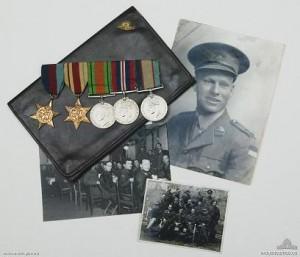The Liberation of Colditz Castle
This 8 cm piece of shrapnel is a souvenir from the liberation of the infamous prisoner of war camp, Oflag IVC - Colditz Castle. It was collected by an Australian soldier, Lieutenant Jack Millett. Millett was an 'incorrigible', one of the prisoners held by the Germans at Colditz for making repeated escape attempts from other camps. In 1942, Millett was caught trying to dig a tunnel out of Oflag VIB at Warburg with another prisoner. In 1943, he took part in a mass escape from Oflag VIIB at Eichstatt. Millett was on the run for five days before he was finally captured by two Hitler Youths with large dogs. After his recapture, he served 14 days detention as punishment and was then sent to Colditz Castle, where he remained until April 1945.
In April 1945, US forces reached the town of Colditz. As they advanced, members of the Schutz Staffel (SS), soldiers and civilians established and reinforced defences in anticipation of an attack. The Americans sent out reconnaissance planes and began ranging shells on the town as preparation for a bombardment.
Meanwhile, in the prison camp, the 'Prominente' prisoners (those with prominent connections who could be used as hostages) had been taken from Colditz on 13 April and were moved towards Austria. On 14 April the German Commandant received an order to also remove the British prisoners from the castle. The Senior British Officer, Lieutenant Colonel William Tod, refused. The inmates knew the end of their captivity was near and did not want to be moved. As neither the Commandant nor his superiors were willing to take responsibility for forcing the prisoners to leave at gun point, they remained in the camp. That afternoon, the shelling of the town began.

The prisoners in the castle laid out a huge homemade Union Jack in the courtyard and spelt out POW with sheets, in the hope the American reconnaissance aircraft would spot them, and the castle would not be shelled. Another Union Jack, and the French flag, were also hung in the camp.
Unfortunately, the Americans did not initially see the flags or makeshift signs. On 15 April their artillery ranged on Colditz Castle and let off some small rounds. They believed the castle housed the remainder of the German garrison and did not realise it was a POW camp. The castle's windows gave excellent views of the battle, and the prisoners cheered as they watched events unfold. However, with the Americans ranging on the castle, the prisoners were ordered to the cellars for safety.
Jack Millett ignored the order, and remained upstairs, watching events unfold. This piece of shrapnel came through a window into the room he was in. Luckily, before the shelling began in earnest, an American soldier spotted the French flag, and upon enquiries discovered the castle was a POW camp.
On 16 April, at 8 am, the Americans advanced towards the castle, crossing the bridge, and liberating the prisoners of Colditz. The inmates were not completely free, however. For their own security they remained in the camp until arrangements could be made to evacuate them safely.
A few days later Jack Millett was flown from Germany to England, arriving on 19 April. He embarked from England for Australia in July, arriving in Sydney in August 1945.

